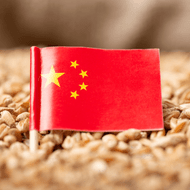China Ramps Up Wheat Imports Amid Crop Shortfalls
Posted by Emily on 7th Nov 2023 Reading Time:
China has increased its wheat imports, securing roughly 2 million tonnes from Australia's new crop and an additional 2.5 million tonnes from France. This move counters the severe damage to nearly a quarter of its wheat harvest due to excessive rainfall.
 malleefarmscapes, CC BY 2.0, via Wikimedia Commons
malleefarmscapes, CC BY 2.0, via Wikimedia Commons
A Strategy to Counter Weather Woes
The country's aggressive purchasing strategy could lead to a record volume of wheat imports this year. Traders believe China is building its reserves while prices are advantageous, following a notable drop in global wheat prices due to Russia's abundant exports.
Unprecedented Buying Patterns
China's acquisitions include two million metric tonnes of Australian wheat arranged in October, earmarked for delivery starting in December. Similarly, about 2.5 million metric tonnes of French wheat have been secured since September for shipment between December and March - volumes that stand out for this season.
Potential Impact on Global Supply
Singapore-based trading experts project that China's imports may top 12 million tonnes in 2023, outstripping last year's high of nearly 10 million tonnes. With a continued appetite for wheat, these numbers could remain high into 2024.
The Quality Quest
Industry insiders point out that China's challenges with crop quality and Australia's reduced output influence Beijing's buying patterns. "They are securing as much as they can, as soon as they can, anticipating a supply pinch, especially from Australia," a Singapore-based trader explained.
China's wheat production fell marginally this year, the first decline in seven years, despite increased planting areas - the main culprit: heavy rains that battered mature grain in key growing regions right before harvest time.
 Gyrostat (Wikimedia, CC-BY-SA 4.0), CC BY-SA 4.0, via Wikimedia Commons
Gyrostat (Wikimedia, CC-BY-SA 4.0), CC BY-SA 4.0, via Wikimedia Commons
Domestic Damage and Global Opportunities
Estimates from trading professionals suggest rain has damaged about 20% of China's harvest, relegating this portion to less desirable uses such as animal feed or blending with higher-quality imports for flour. China's large pork industry, including producers like Muyuan Foods, has turned this situation to its advantage by using the compromised wheat to lower feed costs.
"China's need for quality is Australia's opportunity, especially for high-protein milling wheat," says Stefan Meyer, a grains broker with StoneX in Sydney. Even with Australia's projected decrease in wheat production due to dry conditions, the silver lining is a higher protein content—a boon for quality.
Price Points and Strategic Stockpiling
Analysts within China, like Ma Wenfeng of Beijing Orient Agribusiness Consultancy, affirm that while a portion of the domestic harvest is not up to milling grade, cleaning processes can render it usable. However, the prevailing view is that the compelling prices are what's driving the surge in imports. "Price is the main factor - it's very economical," states Rosa Wang from Shanghai JC Intelligence Co Ltd.
Trade Dynamics and Future Outlook
Despite past bilateral tensions, trade-in Australian wheat to China has remained robust. This focus on Australian wheat might prompt other importers to diversify their sources, potentially turning to North American or Black Sea supplies.
 kallerna, CC BY-SA 4.0, via Wikimedia Commons
kallerna, CC BY-SA 4.0, via Wikimedia Commons
As China begins to import more high-quality wheat from the U.S. and other suppliers, industry observers anticipate a tightening of Australian wheat supplies could lead to price increases. Looking ahead, France is likely to become a more significant supplier to China, according to market analysts.
In summary, China's wheat import strategy is not only a reflection of current domestic needs but also a proactive measure against global market fluctuations and potential future scarcities.

